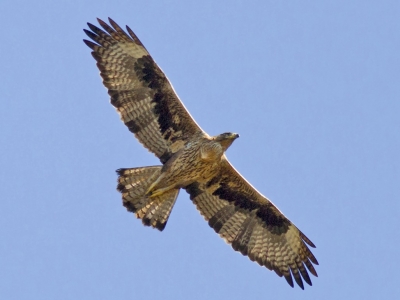
Bonelli’s eagle is named after the Italian ornithologist Franco Andrea Bonelli who first discovered this eagle in 1819. Like all eagles, it belongs to the family Accipitridae. It is found in southern Europe, Africa, across the Middle East and South Asia to Indonesia and also in southeastern China and Thailand and in some parts of India.
It is a medium-sized eagle with a wingspan of 150-170 cm. The upper parts of this eagle are typically dark brown and the underside is white with dark streaks. It has exceptionally long and well-feathered legs and belongs to the Acquilinae or booted eagle subfamily. Its eyes and feet are yellow and its wings are relatively short and rounded. Its tail is long and gray on the top and white below with a broad, black band.
It prefers hilly and mountainous habitats and open woodlands. It eats small birds, mammals, rabbits, fowls and pigeons. It is a very aerial hunter and will circle and soar over its home range looking for prey.
This eagle makes its nest in craggy cliffs or in tall trees. The nest is a huge structure made of branches and sticks and often obscures the sitting female from view. She lays around 1 to 2 eggs, mostly white and sometimes streaked with brown. Incubation lasts for 37-41 days and is mainly done by the female, while the male is in charge of providing food.
In India these eagles are found in certain areas such as Chambal ravines, Ranthambore National Park, Chir zone of lower Kumaon Himalayas and in the Keoladeo National Park of Bharatpur, Rajasthan.
The Bonelli’s eagle has a vast range and is considered ‘least vulnerable’ according to the IUCN. However there is decline in its population due to dwindling prey, human activities, habitat degradation and persecution.
Picture Credit : Google




